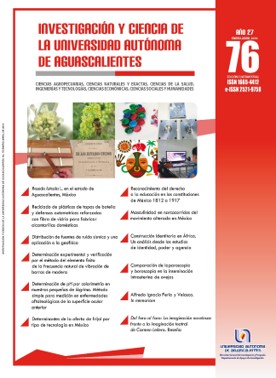Distribution of seismic noise sources and an application to geophysics
DOI:
https://doi.org/10.33064/iycuaa2019761788Keywords:
P and SV waves, Greens function, energy distributions, seismic sources, displacement fieldsAbstract
By correlating the seismic noise, it is possible to recover one of the most important characteristics of the structure of the medium where seismic waves propagate, such characteristic is known as the Green´s function. However, it's necessary to study the influence of the seismic noise distribution in order to estimate whether the recovered Green´s function will be accurate. This work shows a formulation that allows obtaining the Green function for different distributions of seismic noise sources. First, the exact Green functions are used, and the energy contents of the P and SV waves are studied. Afterwards, the relationship of the exact Green function and that recovered by seismic noise is shown. Subsequently, several seismic source distributions are analyzed, mainly isotropic and collinear, and some elements that allow us to assess which of them can lead to obtain the Green´s function with good approximation are exposed.
Downloads
References
• Aki, K. (1957). Space and time spectra of stationary stochastic waves, with special reference to microtremors. Bulletin of the Earthquake Research Institute, 35, 415-456.
• __________, & Richards, P. G. (2002). Quantitative seismology (pp. 11- 34). US: University Science Books.
• Brown, M. G., & Lu, C. (2016). Green’s function retrieval in a field of random water waves. Wave Motion, 60, 8-19.
• Campillo, M., & Paul, A. (2003). Long-range correlations in the diffuse seismic coda. Science, 299(5606), 547-549.
• Garnier, J. (2005). Imaging in randomly layered media by crosscorrelating noisy signals. Multiscale Modeling & Simulation, 4(2), 610-640.
• Garus, D., & Wegler, U. (2011). The Green’s functions constructed from 17 years of ambient seismic noise recorded at ten stations of the German Regional Seismic Network. Bulletin of the Seismological Society of America, 101(6), 2833-2842.
• Ma, S., & Beroza, G. C. (2012). Ambient-field Green’s functions from asynchronous seismic observations. Geophysical Research Letters, 39(6), L06301. doi: 10.1029/2011GL050755
• Ryzhik, L. V., Papanicolau, G. C., & Keller, J. B. (1996). Transport equations for elastic and other waves in random media. Wave Motion, 24(4), 327-370.
• Sánchez-Sesma, F. J., & Campillo, M. (1991). Diffraction of P, SV and Rayleigh waves by topographic features: A boundary integral formulation. Bulletin of the Seismological Society of America, 81(6), 2234-2253.
• Sánchez-Sesma, F. J., Pérez-Ruiz, J. A., Luzón, F., Campillo, M., & Rodríguez-Castellanos, A. (2008). Diffuse fields in dynamic elasticity. Wave Motion, 45(5), 641-654.
• Sato, H., & Fehler, M. C. (1998). Seismic wave propagation and scattering in the heterogeneous Earth. US: Springer-Verlag.
• Shapiro, N. M., & Campillo, M. (2004). Emergence of broadband Rayleigh waves from correlations of the ambient seismic noise. Geophysical Research Letters, 31(7), L07614. doi: 10.1029/2004GL019491
• Stehly, L., Campillo, M., & Shapiro, N. M. (2006). A study of the seismic noise from its long-range correlation properties. Journal of the Geophysical Research, 111, B10306. doi: 10.1029/2005JB004237
• Van Manen, D. J., Curtis, A., & Robertsson, J. O. (2006). Interferometric modeling of wave propagation in inhomogeneous elastic media using time-reversal and reciprocity. Geophysics, 71(4), SI47-SI60.
• Wapenaar, K. (2004). Retrieving the elastodynamic Green’s function of an arbitrary inhomogeneous medium by cross correlation. Physical Review Letters, 93, 254301-1-254301-4.
• Weaver, R. L. (2005). Geophysics. Information from seismic noise. Science, 307(5715), 1568-1569.
• __________, & Lobkis, O. I. (2004). Diffuse fields in open systems and the emergence of the Green’s function. The Journal of the Acoustical Society of America, 116, 2731-2734. doi: 10.1121/1.1810232
Downloads
Published
How to Cite
License
Las obras publicadas en versión electrónica de la revista están bajo la licencia Creative Commons Atribución-NoComercial-CompartirIgual 4.0 Internacional (CC BY-NC-SA 4.0)









